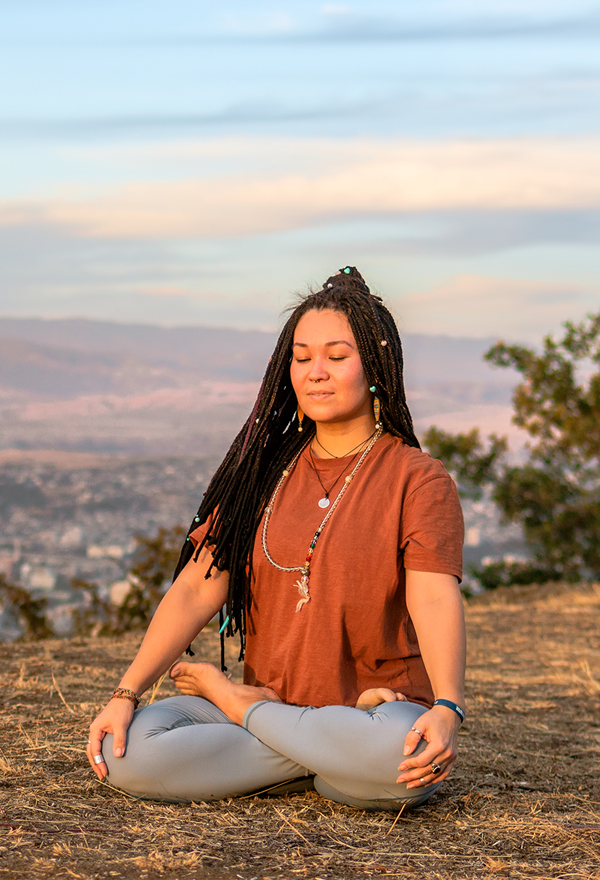What Are Mindfulness And Meditation?
Mindfulness is a state of compassionate awareness, grounded in the present moment. It is a way to be attuned with yourself, others and the world, without judgment.
When in a mindful state, you notice and welcome thoughts, feelings and sensations as they arise. You bear witness to your internal and external experience without labeling it “good” or “bad.” And, you see your thoughts and emotions as just that—thoughts and emotions, with no power to define or control you.
When mindfulness is the goal, meditation is one of the practices that can cultivate it. Throughout centuries, people have used meditative techniques to calm the body and help the mind rest in a soft, quiet, peaceful state.

Although these practices exist across cultures and faith traditions, and are similar to some forms of prayer, they are primarily rooted in Eastern religious practices. In the 1960s, the Buddhist monk Chögyam Trungpa was a major figure in bringing meditative approaches to the West. In the late 1970s, Jon Kabat-Zinn, who holds a Ph.D. in molecular biology, combined Buddhist teachings and scientific research to create a non-religious program called mindfulness-based stress reduction (MBSR). Countless others followed his lead. Now, there is a plethora of research demonstrating the immense psychological benefits of practicing mindfulness.
What Are The Benefits Of Mindfulness?
Meditating regularly to cultivate mindfulness has been shown to change the brain in meaningful ways. This indicates you are not destined to continue in your suffering. You have the power to find lasting relief from a wide range of symptoms, without medication. In fact, meditating for just 15-20 minutes a day can have a dramatic impact on your overall well-being.

Mindfulness can help you:
To learn more about the benefits of mindfulness, click here.
It’s important to note that neither mindfulness nor mediation “treat” disorders. They are helpful tools to reduce stress symptoms and improve overall wellbeing. If you struggle with a mental health disorder, your symptoms are not your fault. No matter how much you meditate, there will still be moments when life feels hard. This is true for everyone, and it doesn’t mean you are “meditating incorrectly” or “not meditating enough.”
Mindfulness should never be something you feel bad at or pressured to achieve. No one is perfectly mindful all the time—that’s why we call this inner work a “practice.” Growth occurs within the process.

How Does Meditation Work?
When most people picture meditating, they often imagine someone sitting in lotus (cross legged position). But there are a wide variety of meditative techniques that can be categorized into various types – not all types are suitable for each person, which is one of the reasons having a guide can be helpful
Broadly, those categories are:
Each technique has nuances, and you might find some address your challenges more effectively than others. I have been practicing meditative techniques for over 30 years, and I can help you discover which practices are best suited to your personality, needs and goals.
Regardless of the specific form, mindfulness exercises are powerful. Once you learn how to meditate, you can more frequently soothe distress and restore a sense of inner equilibrium. Even one minute can shift your experience from chaos to calm—in fact, I often start clients with one-minute practices. If you wish them to be, the mindfulness skills you develop in therapy can be yours for a lifetime.
It is both my personal and professional experience that therapy without a mindfulness-based approach has limited success. On the other side of the coin, mindfulness-based practices that aren’t supported by psychotherapeutic expertise can soften symptoms, but do not generally cure underlying wounds. Working with a therapist who is an expert in both mindfulness and psychology can lead to full, enduring healing.

My Approach To Mindfulness-Based Therapy
In my teens, I struggled with the painful effects of trauma. In an attempt to feel better and “work on myself,” I began practicing yoga and meditating. My main influence at that time was Tibetan/Vajrayana Buddhism as taught by Pema Chödrön and the Zen Buddhism of Thích_Nhất_Hạnh. I later found vipassana meditation and engaged Buddhism as taught by Tara Brach and quickly found some relief and began navigating the world with greater ease. Although mindfulness did not address my deepest wounding, it brought me the peace and empowerment needed to pursue greater healing.
Since then, I have explored a variety of meditative techniques and traditions, including Maitri (loving-kindness) and Tonglen, which both help cultivate compassion toward the self and others. Since my orientation to the world is highly somatic, it’s not surprising that I trained in somatic meditation as taught by Reggie Ray. I am deeply steeped in non-dual mindfulness approaches such as those offered by Loch Kelly. So, may approach to mindfulness and meditation is like the rest of my work, well-rounded and integrative. Integrating body, psyche, spirit, breathwork, and ultimately, a coming home to our own Divinity. It’s possible to discover the deep well of innate wisdom that exists below your conscious awareness. Tapping into this wisdom allows you to heal and thrive.
Mindfulness therapy supports all of the work I do, including anxiety therapy, depression therapy and trauma therapy. Once you have the tools to release distress and find calm, it becomes easier to engage in therapy and other healing work to address challenges at the root. Mindfulness is the first step toward lasting relief.
Live Fully In The Present
If you’d like to explore mindfulness and meditation, you are invited to contact me to schedule a free phone consultation to find out how mindfulness and meditaton practices can support you on your healing journey.
I occasionally teach groups, so please take a look at the Events page to learn more. I also offer private teachings for groups and organizations. You can find more information on the Training and Education page.


